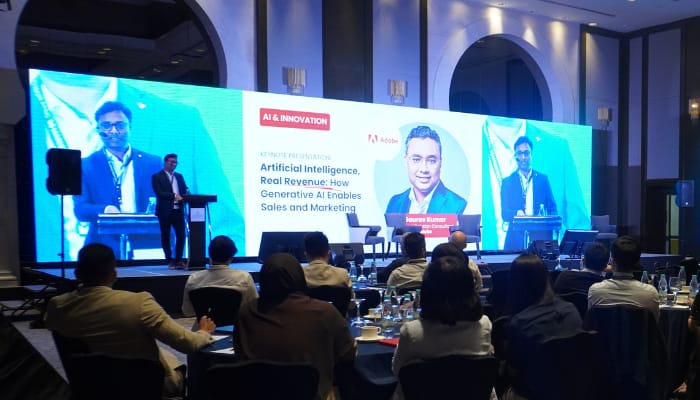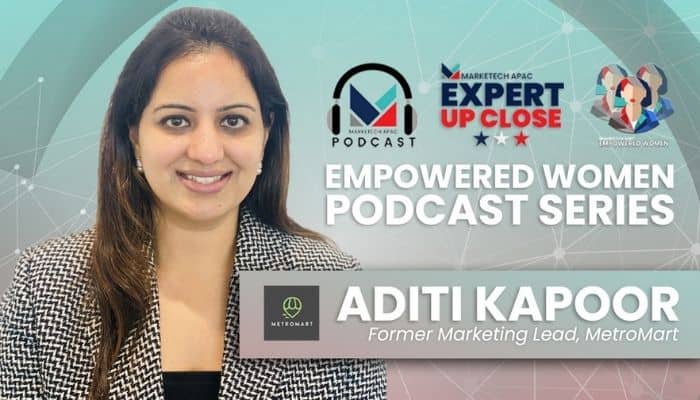Generative AI has become the fastest-adopted technology to date in any history of technology adoption. From creative processes to efficiently creating seamless workflows for enterprises, GenAI is a technology that is showcasing its positive impact across various businesses and industries.
The complexity of adopting GenAI extends to the technical realm, where integrating these advanced algorithms into existing workflows demands a level of expertise that not all businesses possess. The learning curve, coupled with concerns about data privacy and security, poses certain barriers for organisations aiming to leverage generative AI to its fullest potential.
The question is not about what would the scenario be in a GenAI-powered workspace; but rather asking what and how impactful this technology be across a diversity of businesses.
These questions posed are the ones being tackled at the keynote presentation of enterprise technology company Adobe during the recent What’s NEXT 2023: Marketing in Malaysia hybrid conference held at the Sheraton Kuala Lumpur on December 5, 2023.
Gaurav Kumar, principal solution consultant for Southeast Asia at Adobe, dives into the various implications of how GenAI can be a helpful tool for businesses in terms of creativity and workflow optimisation.
How GenAI positively impacts business endeavours
Citing a study from IDC, Kumar notes that by 2026, AI-driven features will be embedded across business technology categories, and 60% of organisations will actively use such features to drive better outcomes without relying on technical AI talent.
During the presentation, he notes how GenAI is a key business need nowadays to optimise customer experience strategies across businesses, as well as sales forecasting, threat and fraud detection, amongst others. It is also worth noting how GenAI is now being used in improving the sales and marketing endeavours of the company, focusing on its use of strategies such as lead identification, personalized outreach, dynamic output, and dynamic customer journey mapping, just to name a few.
In the realm of sales and marketing, he also noted that GenAI can enhance sales and marketing strategies through sophisticated language processing, data analysis, and targeted content generation, optimising customer engagement and driving business growth.
Whether it’s crafting targeted ad copies, generating product descriptions, or curating social media content, generative AI streamlines content creation, allowing marketing teams to focus on strategy and creativity. This not only maximises efficiency but also ensures that messages are not only relevant but resonate with individual consumers, fostering stronger brand-consumer relationships and driving conversions.

Moreover, by purchasing technology with embedded AI capabilities, Kumar notes that businesses will be able to accelerate time to value. Added strategies that businesses may also apply to accelerate their AI strategy include building in-house AI capabilities and leveraging pre-trained AI models through services and/or platforms from third parties, amongst others.
This agility is particularly valuable in rapidly changing markets, allowing businesses to swiftly adapt to new trends and consumer demands. By automating routine processes, generative AI frees up human resources to focus on strategic initiatives, innovation, and value-added activities, contributing to a more agile and competitive business environment.
Lastly, by leveraging advanced algorithms to analyse vast datasets, businesses can gain deep insights into consumer behaviour, preferences, and trends. This enables the delivery of highly personalised and contextually relevant experiences, creating a sense of connection and understanding.
From personalised product recommendations to tailored communication, generative AI empowers businesses to elevate customer satisfaction and loyalty. As customer expectations continue to evolve, the ability to provide a seamless and personalized experience becomes a key differentiator for brands.
How Adobe is establishing the foundation for AI tech across enterprises
For Kumar, Adobe has long been a pioneer in establishing the foundations of AI across its services, categorized under four core pillars: natively integrated AI, AI-as-a-servce (AaaS), reimagined experience management through co-pilot services, and generative visual content services.
Its lead offering, ‘Adobe Sensei’, is a comprehensive AI and machine learning framework that powers various Adobe applications. It is designed to enhance the capabilities of Adobe’s creative and marketing tools by automating repetitive tasks, understanding context, and providing intelligent insights.
He explains further that the company’s approach to GenAI focuses on making sure its services serve best its clients on-brand, a co-pilot for marketers for digital experience design and delivery, and one that is enterprise-ready while making sure all of the outputs are commercially safe.
This is evident in one of their offerings ‘Adobe Firefly’, a generative machine learning model used to create various visual designs. For the company, the datasets used in their service are designed to be safe for commercial use and are trained on Adobe Stock imagery, openly licensed work, and public domain content where the copyright has expired.
Such alignment is important for brands and marketers, as maintaining a positive brand image is essential. Generative AI tools, if not commercially safe, may produce content that is offensive, inappropriate, or inconsistent with the brand’s values. Ensuring safety in the generated content protects the reputation and integrity of the brands that use such tools.
Moreover, he also explains that their offerings revolve around the principles of pushing brands to execute more customer-centric strategies. These include identifying the right customers to target based on their needs and intent, engaging the customers through the right channel at the right time, delivering the right experience for each customer, and measuring how much that experience is driving the right business outcomes.
Kumar’s presentation is part of a series of presentations and discussions under the What’s NEXT 2023: Marketing in Malaysia hybrid conference, where Adobe is a proud platinum sponsor. In it, Adobe had led the discussion not just on the positive impact of GenAI across businesses but also discussed the various insights and advice on the future of customer experience (CX) strategies.
The company’s vast product portfolio across Adobe Creative Cloud, Adobe Document Cloud and Adobe Experience Cloud gives millions of customers—from individual creators to global brands—everything they need to design and deliver exceptional digital experiences.
What’s NEXT 2023: Marketing in Malaysia is part of the trilogy of conferences from MARKETECH APAC’s “What’s NEXT 2023-2024” series. The conference featured a diverse lineup of marketing leaders across Malaysia, representing local and international brands including AEON, Atome, Astro, Boost, CelcomDigi, IHH Healthcare, InterContinental, Gentari, MR. D.I.Y., PropertyGuru, Secret Recipe Cakes & Cafe, Sunway Malls, and Touch ‘n Go Group.











